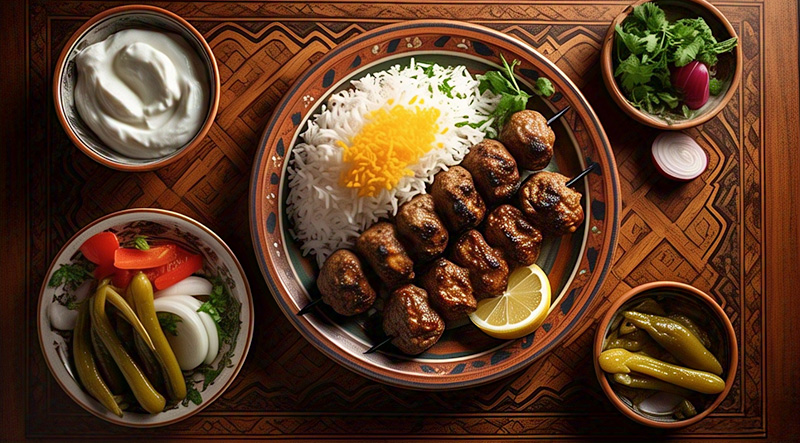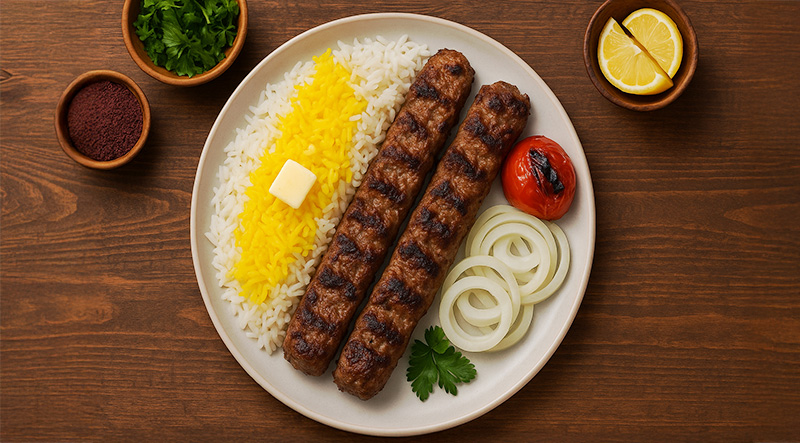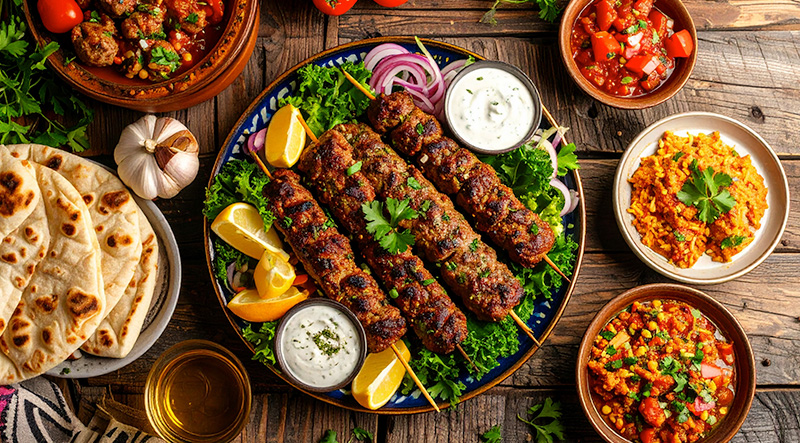The pride of Persian culinary tradition and the essence of Iranian cuisine, Chelow Kabab is succulent, fragrant, and expertly grilled. Tender, saffron-scented kababs, usually made of minced lamb or beef, are served with a heaping pile of buttery basmati rice topped with a golden crust called tahdig in this well-liked national dish. Chelow Kabab, served with grilled tomatoes, fresh herbs, and zesty sumac, is more than just a meal; it's a celebration of fire, flavor, and tradition that brings Iranians together at both festive gatherings and family dinners. Read More...
The History of Chelow Kabab – Iran’s Timeless National Treasure:
Chelow Kabab, the crown jewel of Persian cuisine, holds a special place not only on the Iranian table but also in the heart of its cultural identity. This dish—comprising fragrant saffron rice (chelow) paired with succulent skewered meats (kabab)—is more than just food; it’s a centuries-old symbol of hospitality, tradition, and national pride.
The roots of Chelow Kabab trace back to the ancient Persian Empire, where grilled meats were a staple for royalty and warriors alike. The method of skewering and fire-roasting meat likely evolved from nomadic practices across Central Asia, refined over time by Persian chefs who added their signature use of aromatics, saffron, and marinating techniques. As Persian cuisine flourished during the Safavid dynasty (16th–18th century), so too did Chelow Kabab, gaining prominence in royal courts and major cities like Isfahan and Tehran.
By the 19th century, Chelow Kabab had become firmly embedded in the culinary fabric of Iran. In fact, it was during the Qajar dynasty that the dish was standardized and served with its now-iconic accompaniments: fluffy buttered rice, grilled tomatoes, raw onions, and a dusting of sumac. It also marked the emergence of specialized kabab houses (kababis) that catered to both the nobility and common people, helping the dish spread far and wide.
Today, Chelow Kabab is more than just a national dish—it is a symbol of unity that transcends regions, religions, and social classes across Iran. Whether it’s a homemade feast, a roadside restaurant, or a grand Persian wedding, Chelow Kabab continues to be the centerpiece of countless memorable meals. Its legacy lives on, not only in Iran but wherever Persian culture and cuisine have traveled.
Prepare the kabab mixture:

Par-boil the rice:

Form the tahdig and steam rice:
Skewer and grill the kabab:

Unmold rice & serve:
Enjoy the unforgettable aroma of saffron rice paired with smoky, tender kabab—the very taste of Persian hospitality!
The preparation and cooking time for Chelow Kabab is approximately 1 hour and 30 minutes. This includes about 30 minutes of prep time for mixing and marinating the minced meat with onions and spices, shaping the kababs, and rinsing and soaking the rice. Cooking takes another 60 minutes, including 30–40 minutes to steam the rice to perfection with saffron infusion and 15–20 minutes to grill the kababs until charred and juicy. If preparing additional sides like grilled tomatoes or sumac onions, add another 10–15 minutes.
A single serving of Chelow Kabab, based on the recipe provided, contains approximately 650–750 calories. This estimate includes one portion of Kabab Koobideh (about 150g of meat), a generous serving of saffron rice (~1 cup cooked), and small amounts of butter or ghee used in steaming and drizzling. The kabab contributes the bulk of the protein and fat, while the rice and saffron-butter mixture provide carbohydrates and additional fats. Grilled tomatoes and herbs add negligible calories but enhance the dish with freshness and balance.







